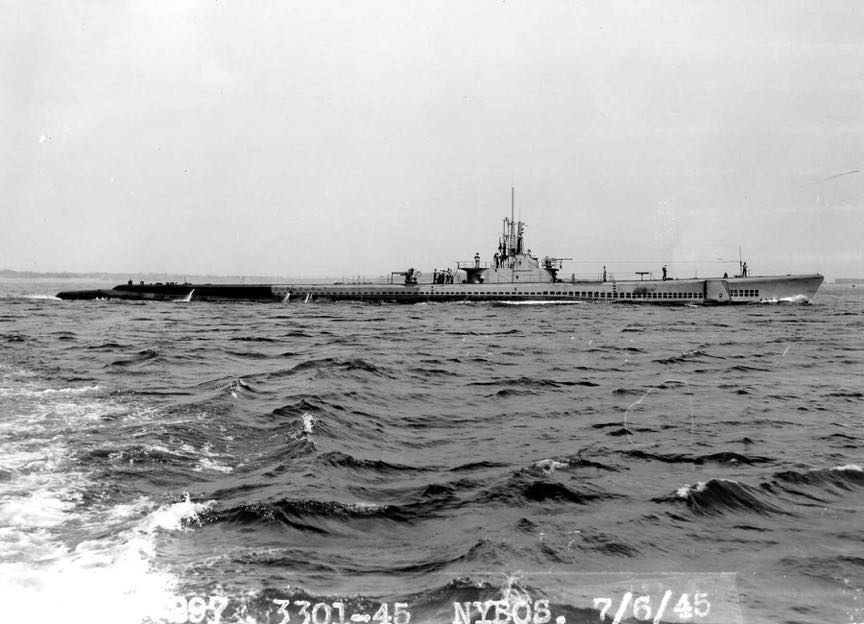Lionfish SS-298

Lionfish
A scorpaenoid fish found in the West Indies and in the tropical Pacific.
(SS-298 dp. 1,526 (std.), 2,424 (subm.); 1. 311'9", b. 27'3"; dr. 15'3''; s. 20.25 k. (surf.), 8.75 k. (subm.);cpl. 66; a 1 5", 10 21" tt.; cl. Balao)
Lionfish (SS-298) was laid down 15 December 1942 by Cramp Shipbuilding Corp., Philadelphia, Pa.; launched 7 November 1943; sponsored by Mrs. Harold C. Train and commissioned 1 November 1944, Lt. Comdr. Edward n. Spruance in command.
After shakedown off New England, Lionfish headed for the Pacific Ocean 8 January 1945. touched at Key West Fla., and arrived Pearl Harbor 25 February.
The submarine departed on her first war patrol 19 March, touched at Saipan, and headed for an area south of Bongo Suido, arriving 1 April. On 11 April Lionfish evaded tv.o torpedoes fired at her by an enemy submarine and on 1 Map, while patrolling in the Yellow Sea, she fired her guns at a Japanese schooner, leaving her in a mass of flames. Later that day she took up lifeguard duty off Shanghai. China, until 9 May when she rendezvoused with submarine Ray, took on board B-29 survivors, and headed for Saipan, arriving 15 May. After discharging her passengers and topping with fuel she headed for Midway, arriving 22 May.
Action bound once more, the submarine sailed 20 June 1945, Comer. B. M. Ganyard in command. for Bungo Suido. On 10 July she sighted and fired upon an /-class enemy submarine. When Lionfish~h reached periscope depth she saw only a cloud of smoke in the direction on her target. Shortly after, Lionfish's crew heard loud breaking-up noises and assumed the submarine kind been sunk, although this could not be reconfirmed from postwar records.
Lionfish exhausted her supply of torpedoes in unsuccessful attacks on two other enemy submarines and headed for lifeguard duty until 18 July when she steered for port, arriving Saipan 21 July.
Torpedoes loaded and refueling completed Lionfish departed next day for lifeguard duty off the Nansei Shoto and Honshu, Japan. She remained in this area until hostilities ended 15 August, then headed for Midway, arriving 22 August. Eight days later Lionfish departed for the west coast, arriving Mare Island Navy Yard 11 September 1945, where she decommissioned 16 January 1946 and entered the Pacific Reserve Fleet.
Lionfish recommissioned 31 January 1951, Lt. Comdr. Arthur G. McIntyre in command. Following shakedown and operations along the California coast the submarine departed San Diego 5 April for the east coast via the Panama Canal, arriving Key West, Fla., 21 April. She served as training ship for the Sonar School until 11 June 1951, when she departed for her new home port, New London, arriving 16 June. She served as training ship and operated out of New London until 25 September when she sailed for training out of Guantanamo Bay, until returning New London 31 October for overhaul and Boston and coastwise training. On 7 July 1952 the submarine began a cruise to Bermuda and Nassau, returning New London 7 August. She sailed 18 October for a Mediterranean cruise, during which she visited Malta and, after participating in NATO exercises, Izmir, Phaleron, Taranto, and Naples. Lionfish headed for the United States 12 December and arrived New London 27 December.
On 30 June 1953 the submarine arrived in Boston Naval Shipyard for deactivation. She was towed to New London 3 November, decommissioned there 15 December 1953, and joined the Atlantic Reserve Fleet.
Lionfish was placed in service in reserve 1 March 1960 towed to Providence, R.I., and moored at the Naval and Marine Corps Reserve Pier. At present she is serving as a reserve training submarine.
Lionfish received one battle star for World War Il service.
